- WildTech interviews Kyran Kunkel, Lead Scientist at American Prairie Reserve, on technology and wildlife management.
- Technologies that help scientists understand species’ movements and habitat use are facilitating the reintroduction of native species to the prairie ecosystem.
- Managing wildlife-livestock conflict will benefit from technology yet still relies on a human presence in the region
Is the Wild West using the most up-to-date technology for managing wildlife and researching conservation issues?
Kyran Kunkel, Lead Scientist at American Prairie Reserve and Affiliate Professor in the Wildlife Biology Program at the University of Montana, wants to ensure that it is. He spoke with WildTech about technologies he relies on for his work on the Reserve and those he has used previously in carnivore research, as well as new technologies he hopes to see for wildlife management and restoration of North America’s grassland ecosystems in the near future.
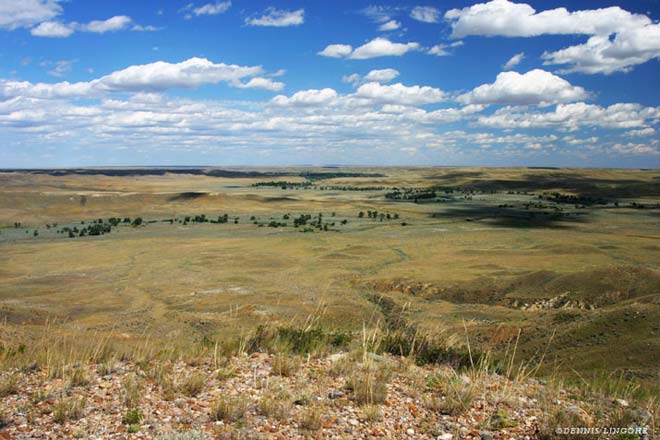
Throughout his career, Kunkel has investigated the movement and foraging patterns of a suite of carnivores, including grizzly bears, wolves, and mountain lions, in the American West. In the late 1990s, he began shifting his attention to helping create and restore American Prairie Reserve – North America’s most expansive wildlife reserve and restoration project, protecting native bison, swift foxes, and pronghorn, among its more iconic mammals.
In helping to initiate the reintroduction of bison back onto the Reserve, located in northeastern Montana, Kunkel is ensuring the species is returned to a portion of its historic native range. We spoke to him about how his team has used technology to better understand the use of the prairie ecosystem by bison and other wildlife.
WildTech: Which technologies have you used for reintroducing bison to the Reserve?
Kyran Kunkel: We have GPS collars on bison. The collars are from Lotek. The data they collect help us better understand how bison use and affect the landscape. Historically, bison numbered in the millions in this area and ranged over large landscapes, influencing the biodiversity. We’ve grown the herd from 16 in 1995 to 620 today, on our way to more than 10,000 animals that will inhabit a range of hundreds of thousands of acres. So it’s important to collect data that show their use and impact on that land. This is an historic opportunity, one that no one will likely get again, and we have an obligation to fully understand it.
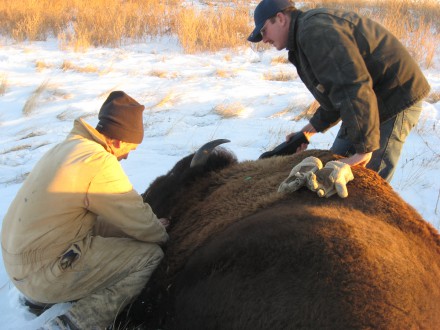
We receive data from the GPS collars every 2 hours and then download that daily through the satellite system. We try to keep 6-8 collars out all of the time — that provides basic animal movement. [When the herd gets bigger], we will need more collars. And one central use of these collars is to understand what’s affecting mortality in the herd. In the rare case that we have a death, we want to get there right away, meaning in the next few days, or else you’ll lose it.
WildTech: Lose it to scavengers?
Kyran Kunkel: Yeah. [You get there right away] so you still have enough clues there to piece together what the mortality source was. This helps give us insight into the general health of the herd. Again, right now it’s extremely rare because we don’t have predation on the herd. But in the future, we’ll be able to monitor what role wolves and other predators play. So, we will need lots of tracking devices to monitor that, and because you need lots, they need to be inexpensive.
WildTech: Will you be reintroducing other species as well?
We [also] want to, hopefully soon, reintroduce swift foxes, a fox about the size of a cat — about a kilo and a half — they’re endemic to the prairie and they’re imperiled. There’s only a few along the Canadian border of Montana, so our plan would be to translocate a few of those animals… to our project area to start a new population.
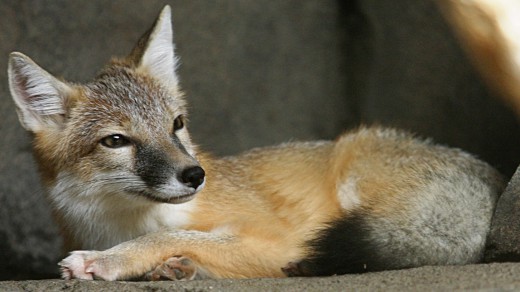
Those are small guys, so the question here would be [finding] something small… [a tracking collar] that won’t come into battery issues, to keep track of mortality. [T]hey will die at a relatively higher rate when first starting because they are new to the place, and the main source of the mortality is probably going to be coyotes. So we will want to know how they are doing and what we need to do to keep the population going.
We will also want to know fine-scale habitat use, too, which would [require] GPS…. These guys go underground — they spend a lot of time in holes, so that makes it a challenge for everything, whether it is VHF or GPS, but they do come out, they move around a lot — morning and evening especially, depending on the season. If they aren’t tied down with pups, they move around a lot. A typical home range for them would be 1,500 acres [600 ha].
One of the technologies used is [Passive Integrated Transponder] PIT tags — they are passive and inexpensive, so they need to be in contact with active receivers, such as stations or towers (including cell towers that might be able to track cellular-based collars) or drones (including to track VHF collars) [to read the tag’s data]. [Researchers] use PIT tags on black-footed ferrets; they put a ring [as a receiver] over the hole, so when the ferrets go through the hole, they set off the tracker. They do spotlighting at night and find where the ferrets are and put a ring over the holes so they can identify which ferret is in that hole. You could theoretically do that with foxes too — with a ring big enough. Such a strategy might work for bison too.
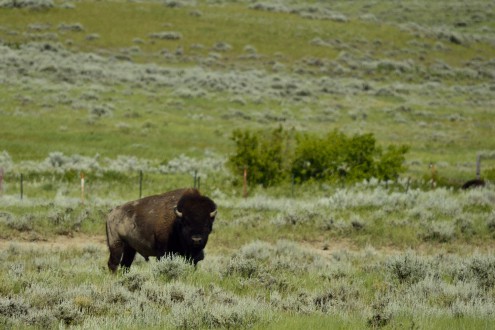
Kyran Kunkel: So that is about what we have currently, for the Reserve. There’s also the regional [mountain] lion study that a group of collaborators completed a year ago now. They were all GPS collars, half were Telonics, which are an Iridium system, and the other half were ATS store-on-board GPS collars that when you captured the cats you got the data back.
WildTech: Do they have VHF [Very High Frequency radio tags] on them too?
Kyran Kunkel: Yes, VHF included. Bison collars have a drop-off mechanism too, so when we had store-on-boards — we don’t use those anymore — they have a drop-off mechanism, so a year later they drop off, and you have a VHF and you can go pick up the collar. But we’ve switched over to having more real-time [GPS tags], just so we know where they are.
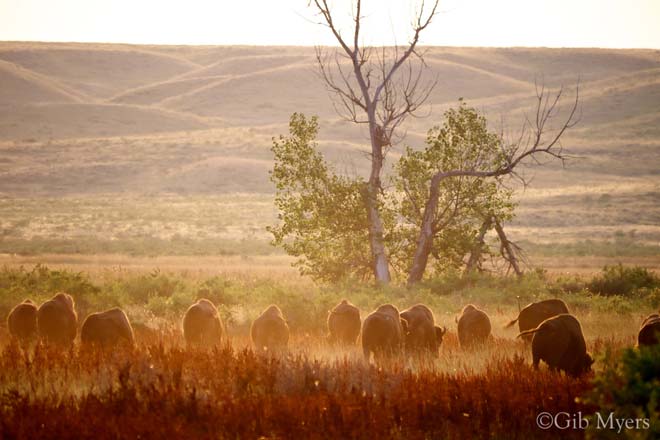
WildTech: Have you collared wolves at all?
Kyran Kunkel: Yes, I have used GPS collars on wolves on projects before this one, [which are] still ongoing. Wolves are pretty easy — they have a big head like a dog, so it’s relatively easy to keep the collar on. They chew [each other’s] collars, so they have to be pretty strong… [The ones I’ve used previously are] also reinforced with some kind of plastic coating. Same way with foxes, the collars have to be a lot smaller and lighter, but they still have to be fairly tough to keep them from being chewed off.
One thing we are trying to get going on the Reserve is trying to monitor animals in relation to livestock. The idea of trying to reduce conflicts between wolves and bears, when they return, and livestock is that you would have some sort of level of vigilance out there… The idea is [having] cowboys and cowgirls on horses riding out and spending time amongst a group of livestock — going out there every day, once a week, something like that — so they get human presence, number one, reducing the chance that wolves are going to show up and, number two, that if they do, then they’re there and they can chase them off.
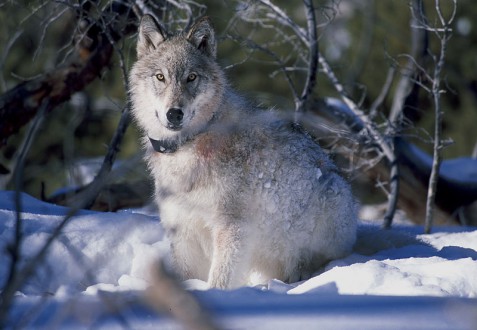
WildTech: How would you use the technology to help reduce predation on livestock?
Kyran Kunkel: [Wolves] would be out there with GPS collars… so you have to know where the wolves are, but the research has not been done…. What we are trying to do is [ask] what does human presence do to GPS locations of wolves, so that if we are there, are wolves still there, hanging around the edges [of their range]? Or do we just chase them out of the country and they go hunt elk for weeks at a time before they come back? That is what we are trying to get to, reduce the problem, but also understand the mechanism for forming that habit.
WildTech: So have you studied any other predator-livestock mitigating techniques?
Kyran Kunkel: The next thing we want to try is dogs, to deter the presence of predators. In Europe they’ve used them for a long time. In the U.S., though, we went away from predator defenses because we got rid of all of the predators. Predators are coming back now, so people are exploring using dogs.
WildTech: That accompany the cattle or livestock?
Kyran Kunkel: Yes, exactly. People historically have used them more for sheep. Sheep are in a bunch and they’re easier — using dogs with cattle is going to be a bigger challenge because the herd is more spread out over a bigger landscape, but people are beginning to explore some breeds of dog that travel farther…. But you’d [still] want to have some human presence too – again, to reinforce.
Wildtech: Have there been any ideas of compensating ranchers who have lost livestock to predators?
Kyran Kunkel: Actually, we’re using an idea we developed for a livestock insurance program in Nepal for farmers who lose livestock to snow leopards and from a proposed program in Namibia on cheetahs and livestock. Rather than paying for lost livestock, we’ve set up camera traps to monitor wildlife on ranches enrolled in our Wild Sky program, which pays ranchers a per-pound incentive on their beef to encourage wildlife-friendly habitat, so when the camera traps capture images of wildlife, we pay them a certain sum of money as an incentive to want to keep wildlife in their range. One issue is that we need software that will “manage” our photos so that we can store only the species we are interested in, identify the species, identify individuals and summarize and curate that data.
[Kunkel shared his final thoughts on the future of technology for conservation issues in the West: tracking technology is important, but he believes the main issue is ensuring a human presence.]
Kyran Kunkel: It comes down to mostly this issue of having some presence, so you know what is going on, and are able to respond in some way. If you can automate that presence (so that it is cheaper than using people) and have that presence [act as a] deterrent — meaning that if it is there, it reduces the chances that bears and wolves are going to show up, because activity is going on that they don’t want to be near — so be it. The challenge in the West is that you’ve got a lot of cattle spread out over large areas so it’s not so confined.
Do you have ideas for ‘automated presence systems’ that could emulate human presence and help to mitigate human-wildlife conflicts? Share your ideas on the Wildtech forum.
This interview was edited for clarity.